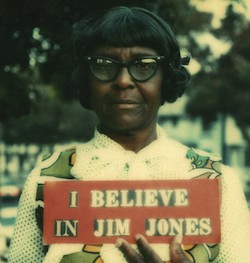 Americans are obsessed with cults.
Americans are obsessed with cults.
With all the election-year talk of “American Exceptionalism” in this floundering economy, one of the most profound, indeed exceptional, American products is the commercialization of cults. The 24-hour news cycle cut its teeth on Waco and David Koresh, and more recently, on the polygamist sect run by Warren Jeffs, who inspired the creators of the HBO series Big Love. But this phenomenon is not limited to television; it extends to the big screen, and even music.
Whether it’s films like Martha Marcy May Marlene, Sound of My Voice, or Red State, 2011 is shaping up to be the year of cults.
I haven’t seen the films yet, but based on the trailers, each manages to convey similar subject matter while maintaining a unique identity. What I have seen, and can’t stop listening too, is the debut album Cults from the Manhattan band Cults.
In “Abducted” the opening lines: “I knew right then that I’d been abducted/ I knew right then that he would be taking my heart,” at once set up a dark, but also potentially lovelorn, pairing. However, the music video directed by David Altobelli for “Abducted” quickly dispels any notions of innocent romance.
The video opens with an icebound, lonesome setting of a bound, bewildered woman lying on a frozen road. The sense of space grips the viewer as the camera takes long pauses on the surrounding scenery, telling the woman’s story in fractured time of how she came to be on the road. “Abducted” is a love story, and like all good love stories it’s dark, twisted and full of pain. The beauty in the video, and likewise in the song, is that the male and female roles are mirrored; love becomes a crime, stealing someone’s heart, abducting it, is shown as being as physically violent as it often psychically feels.
The melodic, repetitive tones and phrasing of pop music form the perfect vehicle for Cults’ subject matter. Pop music is really a chant set to beat, often played in the background, unnoticed at parties, yet still reaching listeners on a base level. It’s also socially accepted, much more so by parents than other forms of rebellious music. Which should be surprising, considering John Cusack’s opening monologue to High Fidelity, based on the book by Nick Hornby:
What came first, the music or the misery? People worry about kids playing with guns or watching violent videos, fearing some sort of culture of violence will take them over. Nobody worries about kids listening to thousands, literally thousands of songs about heartbreak, rejection, pain, misery, and loss. Did I listen to pop music because I was miserable, or was I miserable because I listened to pop music?
We consume pop music at a staggering rate, worshipping its lyric beats at such speed that we often don’t pause and reflect, as John Cusack’s record store owner did, just how damaging this bombardment of painful music can be to our psyches.
Losing one’s self to the power of another is at the core of every cult, and it is what drives Cults’ “Go Outside,” video directed by Isaiah Seret.
Go Outside, by Cults from Boing Boing on Vimeo.
The music video is provocative. It painstakingly inserts the band members into actual footage taken from the Jonestown massacre, the greatest modern cult killing. It’s a bold, attention-grabbing attempt, one which firmly cements the band with its chosen theme. Unexpectedly, the video also manages to convey an upbeat, even blissful tone, perhaps because it consciously avoids the shock value footage from the massacre’s aftermath. Don’t get me wrong, there remains a truly dark and sinister undertone in both the video and lyrics; however, there resides a profound innocence in these lyrics, just as there is a profound innocence, a yearning for belonging in each person who is drawn to join a cult like The Peoples Temple.
Losing ourselves in others, though potentially tragic and painful, is uniquely human, and should be celebrated. It’s human, too, to find comfort in contradictions; love is control and pain is joy.
Marc Watkins lives in Oxford, Mississippi. He has published or had work recently accepted for publication in The Pushcart Prize XXXV (2011), Poets & Writers, StoryQuarterly, Texas Review, Third Coast, and Boulevard. He recently served as a guest fiction editor for Pushcart Prize XXXVI (2012).

I am anticipating the Martha Marcy May Marlene movie, since I also grew up in a religious cult. Interesting how you deduced that 2011 is the year of cults. From what I have studied, cults come into focus every so often…especially around the times of predicted apocalypses.
That’s fascinating, M.E.! I know there are a lot of alumni, if you can say that, or kids of members of Children of God (now The Family?) that end up leaving and forming lives outside. I’ve been suprised to read how international that particular groups is. I also remember reading about the Millerites in the 19th century. In their case, it was their leader, not the Mayan long count, predicting an apocalypse in 1843 with the second coming of Christ. But I think you’re right. Catastrophism must help cult membership.